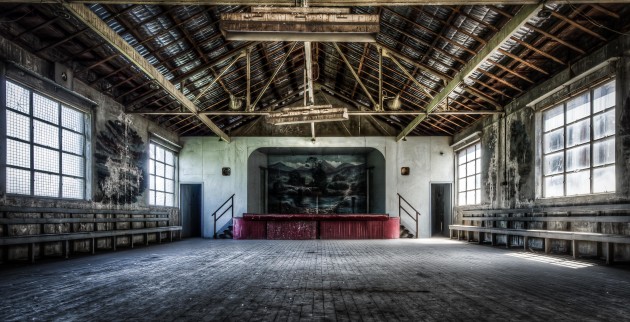
Brett Patman may well be the luckiest person in Sydney. No, he didn’t win the lottery, although some photographers might think that he had. Patman is one of a very select few who have been allowed access to Sydney’s White Bay Power Station, having wondered what it looks like for as long as he could remember. The site had been was in operation from 1917 until 1983, and ever since then it’s been entirely off-limits, notwithstanding the once in a Blue Moon “open days”, where visitors were able to peer into some of the buildings through Perspex windows. The site has been earmarked for a $2 billion transformation, so the historical value and importance of this series is certain to increase dramatically.
For the shoot, Patman was require to wear a full-body overall with a hood, boots and dust mask the entire time he was inside. And on a 32-degree day, he says that things got pretty sweaty. During his time on site, he was given the grand tour by one of the long-standing security guards, Steve, who has watched over the site since 1995. And suffice to say, he’s seen his fair share of would-be intruders.

Patman describes the experience as surreal. “I’ve never shot anything like this before, so to actually get the opportunity was really exciting,” Patman says. “I couldn’t believe it was happening. All the time I was walking around, in my head I kept saying, ‘ohmygodohmygodohmygod!!!’” Allowed a four-hour window, the shoot ended up taking an extra hour and half, and luckily for Patman, Steve proved to be tremendously accommodating, working through lunch to assist Patman, all the while telling him not to worry if things were taking a little longer than anticipated.
Patman thrives on shooting abandoned spaces and admits that this was by far the most exciting shoot he’s ever done. “It was actually very calm which was a welcome change from the usual feel of terror when I shoot alone in abandoned buildings,” he says. “I’ve run into squatters, copper thieves, police, other photographers, and graffiti artists. You’d be surprised how active some of these places are.”

Access
How Patman was granted such amazing access to the site remains something of a mystery, and one wonders if there wasn’t some sort of bureaucratic error that allowed him to fly under the radar. Essentially, outside access to the site is non-existent, and more so now that proposed developments are under consideration. “I still don’t know who actually approved this,” Patman says. “I still can’t believe how lucky I am. I’d like to return and shoot it again. Whoever is tasked with redeveloping it should call me in to photo document the entire site from top to bottom,” he suggests with a smile.
Gear and approach
The series was shot on a Nikon D7000 with 14-24mm f/2.8 on a tripod with a remote trigger. All the HDR shots relied on up to nine merged exposures. Patman says that once he’s merged the images for HDR, he likes to push the editing pretty hard. “I try to blur the line between photography and digital art,” he says. “I feel like editing accounts for half of what makes my shots look the way they do.”

The future
Patman picked up photography as a hobby about five years ago. For his day job, he works as an assistant hydrographer for Sydney Water. Going forward, Patman is planning to expand his portfolio on abandoned sites and has his eye on the Wakil properties – a suite of deserted buildings scattered around the Sydney CBD. “They are some of the best examples of a time gone by in Australia, preserved as it was. They are some of the next [sites] to be lost forever.” Recently, Patman documented the Callan Park Hospital for the Insane (1878 – 1914). The site was closed in 2008. But the location that he’d most like to photograph is the now uninhabited Japanese island, Hashima, 15 kilometres from Nagasaki. The island’s population peaked in 1959, with just over 5,200 people living three. But until he gets access there, Patman will have his sights set closer to home.
www.lostcollective.com


















